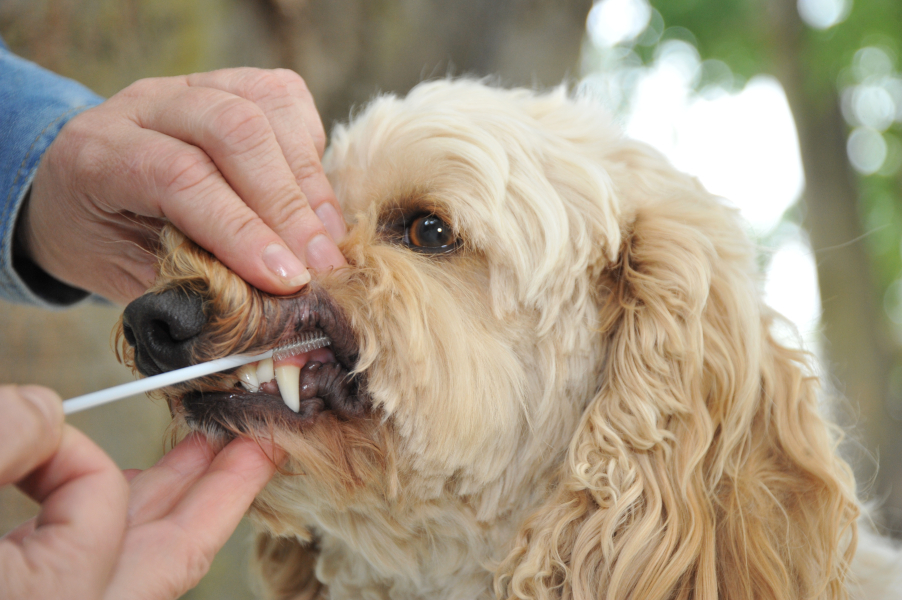Quick Summary
Click here for Price and Turnaround Time
Phenotype: Adverse owner-reported behaviors (such as seizure, “glazing over”, episodic biting, and general loss of clarity) in the Belgian Malinois have been associated with certain genetic polymorphisms in the dopamine transporter gene.
Breeds appropriate for testing: Belgian Malinois
Explanation of Results:
- A0/A0, A0/A10, and A10/A10 genotypes have not been associated with adverse behavior of Belgian Malinois.
- A0/A22 and A10/A22 genotypes are associated with behavior considered by some owners to be adverse and/or potentially undesirable in Belgian Malinois.
- A22/A22 genotype is associated with the most extreme behavior considered adverse and/or potentially undesirable in Belgian Malinois.
Sample Collection
Dog DNA tests are carried out using cells brushed from your dog's cheeks and gums. The preferred cytology brushes are sent to you by mail, or you may provide your own brushes. For accepted alternative brushes, click here
We recommend waiting until puppies are at least three weeks old before testing.

Step-By-Step:
- Make sure the dog has not had anything to eat or drink for at least 1 hour prior to collecting sample.
- When swabbing puppies, isolate each puppy from the mother, littermates and any shared toys for 1 hour prior to swabbing. Puppies should not have nursed or eaten for 1 hour prior to collecting sample.
- If collecting samples from more than one dog, make sure to sample one dog at a time and wash your hands before swabbing another dog.
- Label brush sleeve with name or ID of dog to be sampled.
- Open brush sleeve by arrow and remove one brush by its handle.
- Place bristle head between the dog’s gums and cheek and press lightly on the outside of the cheek while rubbing or rotating the brush back and forth for 15 seconds.
- Wave the brush in the air for 20 seconds to air dry.
- Insert brush back into sleeve.
- Repeat steps 5 - 8 for each unused brush in sleeve on a fresh area of cheek and gums. Make sure to use and return all brushes sent by the VGL. In most cases, it will be 3 brushes per dog. If using interdental gum brushes, please note that the VGL requires 4 brushes per dog and only moderate or wide interdental gum brushes are accepted.
- Do not seal brushes in sleeve.
- Place all samples in an envelope and return to the address provided.
ATTENTION:
- Do not collect saliva/drool – the key to obtaining a good sample is getting cheek cells on the swab
- Do not rub swab on the dog’s tongue or teeth – this will result in poor quality sample
- Do not collect a sample from a puppy that has recently nursed – the mother’s genetic material can rub off on the puppy’s mouth and contaminate the sample
The dopamine transporter gene (SLC6A3) is relevant to aggression and other behavioral changes across species. SLC6A3 encodes a protein responsible for regulation of signal amplitude and duration in dopaminergic synapses in the brain. Research by Drs. Lisa Lit, Anita Oberbauer, and colleagues at the Department of Animal Science, University of California, Davis identified two polymorphisms in the SLC6A3 gene associated with owner reports of seizure, “glazing over” behaviors, episodic biting behaviors, and general loss of clarity in the Belgian Malinois. These polymorphisms have further been associated with increased aversive treatment of dogs by handlers, and increased stress in dogs in response to handlers. For dogs whose owners reported these behaviors, these closely linked polymorphisms were more likely to be present. One of these polymorphisms, PolyA(22), is also associated with increased activity in both novel and familiar environments. Among the two polymorphisms, PolyA(22) is a better predictor of behavior. To date, an association between the polymorphism(s) and behavior/seizure has not been confirmed in breeds other than the Belgian Malinois. Findings were obtained using primarily working lines of Belgian Malinois. Because of the complex nature of behavior, it is possible that environmental factors such as stress may contribute to the expression of adverse owner-reported behaviors.

 Behavior Propensity in Belgian Malinois
Behavior Propensity in Belgian Malinois